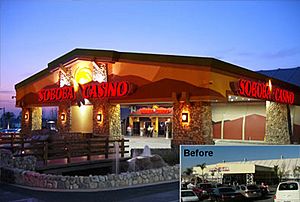Soboba Band of Luiseño Indians facts for kids
 |
|
| Total population | |
|---|---|
| 522 | |
| Regions with significant populations | |
| United States (California) | |
| Languages | |
| Luiseño, English, and Spanish | |
| Religion | |
| Traditional tribal religion, Christianity | |
| Related ethnic groups | |
| other Luiseño tribes, Ajachmem (Juaneño), Cupeño, Cahuilla, Serrano, Gabrieliño-Tongva and Chemehuevi |
The Soboba Band of Luiseño Indians is a Native American tribe. They are part of the Luiseño people. Their main offices are in Riverside County, California. The United States government officially recognized the Soboba tribe.
On June 18, 1883, the Soboba Reservation was created. This special land is located near San Jacinto. There are five other Luiseño tribes that are also officially recognized in southern California.
Contents
History of the Soboba Tribe
Early Encounters and Land Changes
The Luiseño people first met Europeans when missionaries came to their lands. The Luiseño allowed these visitors to pass through their community. Writers traveling with the missionaries recorded much about the Luiseño culture.
In 1776, a Spanish group led by Juan Bautista de Anza traveled through California. This group included missionaries and soldiers. They claimed the Luiseño homeland for Spain. This land was used for cattle ranches connected to the San Luis Rey Mission.
A priest named Father Jose Sanchez wrote about this time. He said, "We stopped at Jaguara, which the natives called it. We called it San Jacinto. This is where the cattle for Mission San Luis Rey de Francia are kept."
Establishing the Soboba Reservation
After the United States took control of California, the Soboba people got their land back. The Soboba Reservation was officially created on June 18, 1883. This happened through a special order from the government.
Life on the Soboba Reservation
A Strong Community Today
The Soboba Band of Luiseño Indians has built a community that supports itself. They have created many businesses, including farming and entertainment. Because of these businesses, the Soboba tribe has a strong economy.
The tribe has also built its own schools. One example is Noli Indian School, which teaches students from first grade to twelfth grade. They have also started non-profit groups and charities. These groups use money from the tribe's businesses to help others.
How the Soboba Tribe Earns Money
Farming and Agriculture
The Soboba tribe first built their economy through farming. They started by growing apricots. Over time, they developed the land around their reservation for more farming. Many tribe members also worked in the citrus fruit industry nearby. This farming helped them grow their economy.
Soboba Casino and Resort
In the late 1900s, the Soboba tribe opened a gaming casino. This casino helps them earn money for their community. It also supports their people. Because their reservation is sovereign land, they can run a casino under California and federal laws.
The Soboba Casino is a popular place for gaming in California. It is about 100 kilometers (62 miles) from Los Angeles. Many people from all over California visit it. The casino is the biggest source of income for the tribe. It continues to grow and bring in more money every day.
Fun Things to Do at Soboba
The Soboba tribe has also built a country club. This club has golf tournaments and a resort with rooms for guests. The resort opened in May 2008. From 2009 to 2012, the resort hosted a big golf event called the Soboba Golf Classic.
Images for kids




